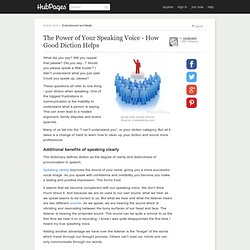

Dalton - Some Techniques for Teaching Pronunciation. The Internet TESL Journal David F.

Daltonddalton [at] academ01.chs.itesm.mxChiapas, Mexico Background When I did my initial training as an E.F.L. teacher, one of the course tutors always described pronunciation as "the Cinderella of language teaching", i.e. she never got to go to the ball. By this he was referring to the often low level of emphasis placed on this very important language skill. We are comfortable teaching reading, writing , listening and to a degree, general oral skills, but when it comes to pronunciation we often lack the basic knowledge of articulatory phonetics (not difficult to aquire) to offer our students anything more than rudimentary (and often unhelpful) advice such as, "it sounds like this ; uuuh". There is also a tendency for us to focus on production as the main problem affecting our learners.
Techniques : Exercise should be simple, accessible , fun and combine reception and production. Exercise A : Stage 1 : Stage 2 : Train Your Accent: ESL Accent Reduction Training and Conversational English. The Power of Your Speaking Voice - How Good Diction Helps. Excercises for consonant placement and successful diction The following excercises may help you with your consonant placement.

They excercise your muscles for speech: Bilabial - sounds made with the two lips together. Sometimes we mumble and fail to pronounce our words properly because we don't know how to position our tongue and teeth. While speaking the above bilabial exercise, pay attention to how the tongue is positioned in the mouth. Labiodental - upper teeth on lower lip. Linguadental - tongue between teeth. Lingua alveolar - tongue tip against upper teeth. Lingua alveorlar - tongue tip positioned against lower teeth. Lingua palatal - tongue is against the roof of the mouth (hard palate) Lingua velar - tongue against the soft palate or uvula. Glottal - layrnx or voice box. Practice these diction exercises for a few minutes each day to get the best results. Common mistakes in pronounciation The way you pronounciate your words is a major factor in influencing people. Diction Exercises - Tongue Twisters to Learn How to Speak Clearly.
- articulation drills to make sure they get your message.

The Storyteller's Tool Kit: THE VOICE. The Storyteller's Toolkit is a simple way to talk about the elements that storyteller's use to present a story.

These do not include puppets, props, costumes or anything extraneous. You can certainly use all of those things as a storyteller, but they are not standard tools in the toolkit. The basics in the toolkit are as follows. Voice: Eyes: If you missed the post, click here. Face: If you missed this pos, just click here. Hands: If you missed the post, click here. Body: If you missed the post, just click here. Voice And Speech Training. 6 Simple Ways To Improve The Way You Speak. Business leaders pay a great deal of attention to communication.

Mastering what you need to say and how you need to say it are important factors if you’re going to be an effective communicator. However, one element of spoken communication is often overlooked--the way you speak. We’ve all heard people whose voices are too grating, soft, or fake. Some people’s speech is so unpleasant that they undermine the speaker’s message entirely. However, you can take steps to improve the quality, tone, and expression of your voice, and how you express yourself vocally. 1. One of the most important things you can do to improve the clarity of your message is to slow down, says Katie Schwartz, president of Durham, North Carolina speech coaching firm Business Speech Improvement.
A good benchmark is to speak slow enough that, if you were reciting a phone number, the person listening to you would be able to write it down. Speak to Be Heard: Developing a More Powerful Voice. « Back to Blog Posts When you speak socially or professionally, how can you be sure your voice is being heard?

(To move listeners to a positive response every time you speak, download my essential sheet sheet, "5 Key Tools of Vocal Dynamics. ") That's a question you should be asking yourself, all of the time. There's a figurative aspect to it, of course—your "true voice" that you want people to hear. But there's also the physical aspect of speaking with enough power and command that everyone present is compelled to pay attention and be persuaded.
“Why Don't We Stand?” Let's begin with the choice of standing vs. sitting when you speak, because it's important in terms of producing a powerful voice. The group I was training was a team of negotiators. I was genuinely surprised to learn that some of these negotiators had soft voices that would lull any listener into inattention. If You're Not Breathing Diaphragmatically, You're Not Breathing for Speech First Circle, Second Circle, Third Circle. 5 Key Tools Vocal Dynamics. Comment travailler votre voix afin de révolutionner vos relations aux autres? Your voice is fine just the way it is. Don't force it.